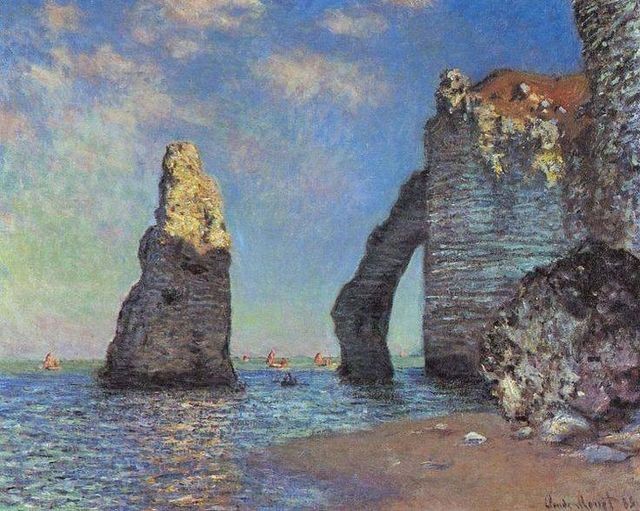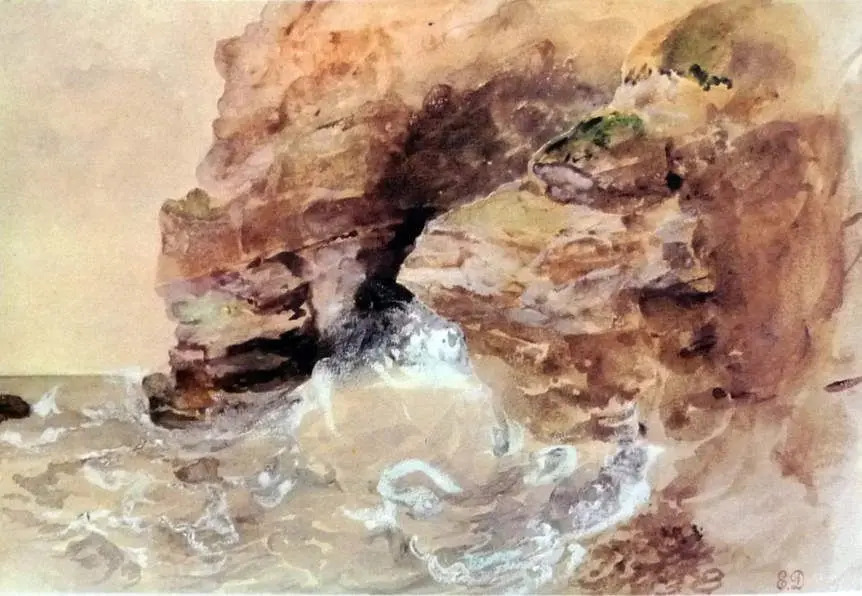
Grove Koger
In my post for February 8, 2023, I mentioned the various factors that might draw artists to a particular locale. In the case of Étretat (ay-treh-tah), a community on the French coast of the English Channel near Le Havre, the combination of scenery and proximity to a major metropolitan area—Paris—seems to have been ideal. What’s more, a 142-mile rail line between the French capital and Le Havre by way of Rouen was completed in early 1847.
Étretat lies on what’s known as the Côte d’Albâtre, or Alabaster Coast, so named for the pale chalk cliffs that stretch along its coastline. At Étretat, these cliffs are spectacular, with some reaching a height of 300 feet, and they’ve proved inspiring to several generations of painters—and writers. Guy de Maupassant (1850-1893), who spent many years there as a child, compared one of the chalk arches, the Manneporte, to a “vault through which a ship could pass,” and wrote that another reminded him of an elephant dipping its trunk into the sea. He later built a house in the area.
Étretat had been a poor fishing village at the beginning of the nineteenth century, but over the course of the following decades, sea bathing became popular with France’s middle class, and they proceeded to take over the pebbly beach. Interestingly enough, some painters ignored them while others celebrated them.

One of the earliest artists to visit Étretat was Ferdinand Victor Eugène Delacroix (1798-1863), who captured the savagery of the coast in the striking watercolor you see above, Waves Breaking on the Cliffs of Étretat (1849). Two decades later, Gustave Courbet (1819-1877) rendered that same savagery in even starker terms in Seascape at Étretat (1869), below.

However, Eugène Lepoittevin (1806-1870) had already recorded the little community’s transformation in the lively painting you see below, Bathing at Étretat (1866). The fellow preparing to dive into the water is thought to be Maupassant.

Claude Monet (1840-1926), who had lived in Le Havre as a young man, was a later visitor. He traveled there for the first time in 1868-69 in the company of his wife, Alice, and son, and eventually produced more than 90 paintings of the area. He found the crowds distracting, and so usually traveled to Étretat in the fall and winter—seasons in which the spectacular scenery was rendered even more dramatic thanks to the turbulence of the surf. As he wrote to Alice on a later visit in 1883, “You have no idea how beautiful the sea has been the past few days. The talent one would need to depict this is enough to drive one crazy.” The image you see at the top of today’s post is his Cliffs at Étretat (1885), while the one below is The Manneporte near Étretat (1886).
In Monet’s world, it would seem, the bathers have never arrived.

If you’d like to subscribe to World Enough, enter your email address below:
And if you’ve enjoyed today’s post, please share!